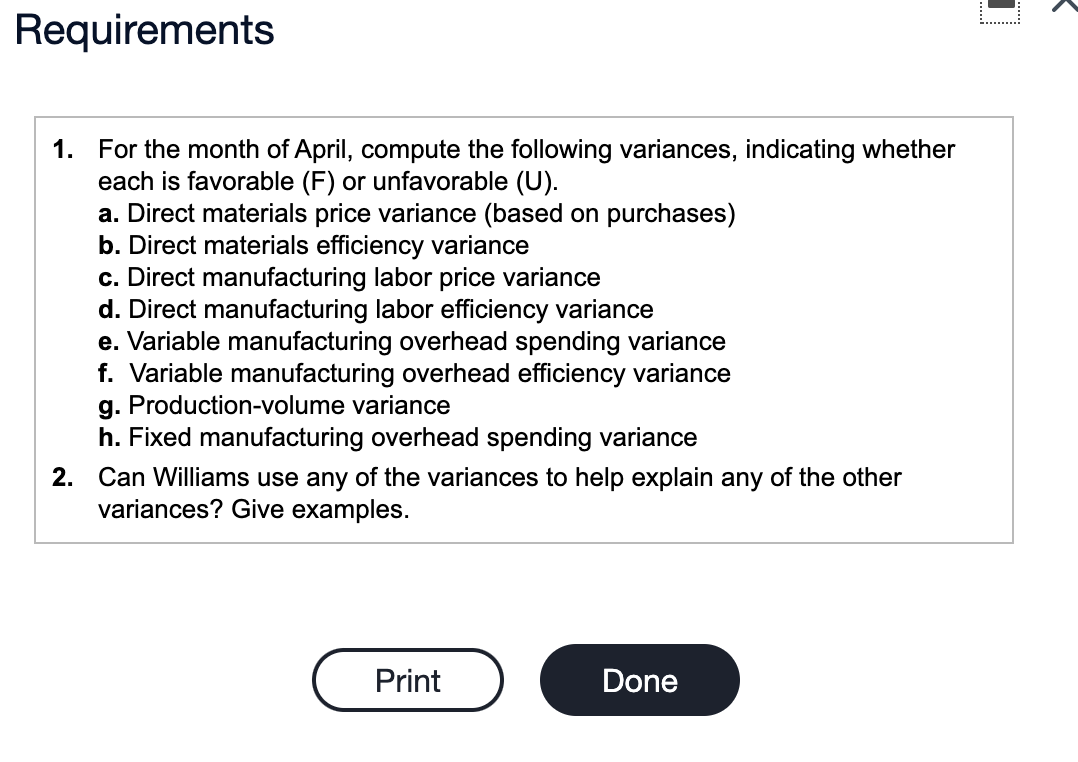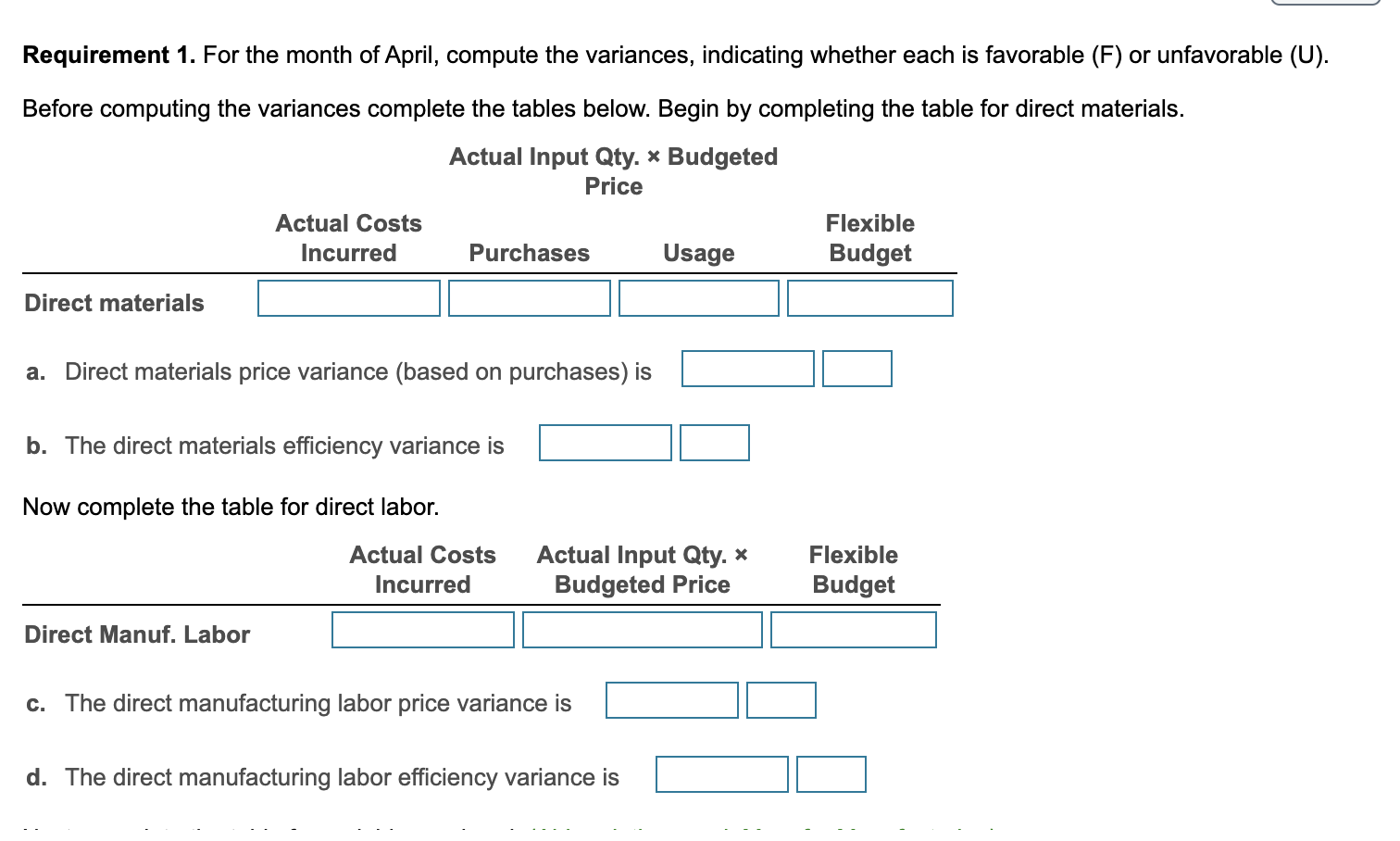




Data table At the beginning of 2017, DDC budgeted annual production of 420,000 doorknobs and adopted the following standards for each doorknob: Input Cost/Doorknob Direct materials (brass) 0.3 lb. @ $10/1b. $ 3.00 Direct manufacturing labor 1.2 hours @ $17/hour 20.40 Variable manufacturing overhead $5/lb x 0.3 lb. 1.50 4.50 Fixed manufacturing overhead $15/1b. x 0.3 lb. $ 29.40 Standard cost per doorknob Print Done Requirements 1. For the month of April, compute the following variances, indicating whether each is favorable (F) or unfavorable (U). a. Direct materials price variance (based on purchases) b. Direct materials efficiency variance c. Direct manufacturing labor price variance d. Direct manufacturing labor efficiency variance e. Variable manufacturing overhead spending variance f. Variable manufacturing overhead efficiency variance g. Production-volume variance h. Fixed manufacturing overhead spending variance 2. Can Williams use any of the variances to help explain any of the other variances? Give examples. Print Done Requirement 1. For the month of April, compute the variances, indicating whether each is favorable (F) or unfavorable (U). Before computing the variances complete the tables below. Begin by completing the table for direct materials. Actual Input Qty. * Budgeted Price Actual Costs Incurred Purchases Flexible Budget Usage Direct materials a. Direct materials price variance (based on purchases) is b. The direct materials efficiency variance is Now complete the table for direct labor. Actual Costs Incurred Actual Input Qty. * Budgeted Price Flexible Budget Direct Manuf. Labor C. The direct manufacturing labor price variance is d. The direct manufacturing labor efficiency variance is d. The direct manufacturing labor efficiency variance is Next, complete the table for variable overhead. (Abbreviation used: Manuf = Manufacturing) Actual Costs Actual Input Qty. * Flexible Allocated Incurred Budgeted Price Budget Overhead Variable Manuf. OH e. The variable manufacturing overhead spending variance is f. The variable manufacturing overhead efficiency variance is Complete the table for fixed overhead. Same Budgeted Lump Sum Regardless Actual Costs Flexible Allocated Incurred of Output Level Budget Overhead Fixed Manuf. OH g. The production-volume variance is h. The fixed manufacturing overhead spending variance is Requirement 2. Can Williams use any of the variances to help explain any of the other variances? Give examples. The direct materials price variance indicates that DDC paid for brass than they had planned. If this is because they purchased a quality brass, it may explain why they used brass than expected (leading to a(n) material efficiency variance). variable overhead efficiency variance. The purchase of this quality of brass may also explain why it took In turn, since variable manufacturing overhead is assigned based on pounds of materials used, this directly led to the labor time to produce the doorknobs than expected (the direct labor efficiency variance). Finally, the direct labor price variance could imply that the workers who were hired were experienced than expected, which could also be related to the direct material and direct labor efficiency variances. Data table At the beginning of 2017, DDC budgeted annual production of 420,000 doorknobs and adopted the following standards for each doorknob: Input Cost/Doorknob Direct materials (brass) 0.3 lb. @ $10/1b. $ 3.00 Direct manufacturing labor 1.2 hours @ $17/hour 20.40 Variable manufacturing overhead $5/lb x 0.3 lb. 1.50 4.50 Fixed manufacturing overhead $15/1b. x 0.3 lb. $ 29.40 Standard cost per doorknob Print Done Requirements 1. For the month of April, compute the following variances, indicating whether each is favorable (F) or unfavorable (U). a. Direct materials price variance (based on purchases) b. Direct materials efficiency variance c. Direct manufacturing labor price variance d. Direct manufacturing labor efficiency variance e. Variable manufacturing overhead spending variance f. Variable manufacturing overhead efficiency variance g. Production-volume variance h. Fixed manufacturing overhead spending variance 2. Can Williams use any of the variances to help explain any of the other variances? Give examples. Print Done Requirement 1. For the month of April, compute the variances, indicating whether each is favorable (F) or unfavorable (U). Before computing the variances complete the tables below. Begin by completing the table for direct materials. Actual Input Qty. * Budgeted Price Actual Costs Incurred Purchases Flexible Budget Usage Direct materials a. Direct materials price variance (based on purchases) is b. The direct materials efficiency variance is Now complete the table for direct labor. Actual Costs Incurred Actual Input Qty. * Budgeted Price Flexible Budget Direct Manuf. Labor C. The direct manufacturing labor price variance is d. The direct manufacturing labor efficiency variance is d. The direct manufacturing labor efficiency variance is Next, complete the table for variable overhead. (Abbreviation used: Manuf = Manufacturing) Actual Costs Actual Input Qty. * Flexible Allocated Incurred Budgeted Price Budget Overhead Variable Manuf. OH e. The variable manufacturing overhead spending variance is f. The variable manufacturing overhead efficiency variance is Complete the table for fixed overhead. Same Budgeted Lump Sum Regardless Actual Costs Flexible Allocated Incurred of Output Level Budget Overhead Fixed Manuf. OH g. The production-volume variance is h. The fixed manufacturing overhead spending variance is Requirement 2. Can Williams use any of the variances to help explain any of the other variances? Give examples. The direct materials price variance indicates that DDC paid for brass than they had planned. If this is because they purchased a quality brass, it may explain why they used brass than expected (leading to a(n) material efficiency variance). variable overhead efficiency variance. The purchase of this quality of brass may also explain why it took In turn, since variable manufacturing overhead is assigned based on pounds of materials used, this directly led to the labor time to produce the doorknobs than expected (the direct labor efficiency variance). Finally, the direct labor price variance could imply that the workers who were hired were experienced than expected, which could also be related to the direct material and direct labor efficiency variances











